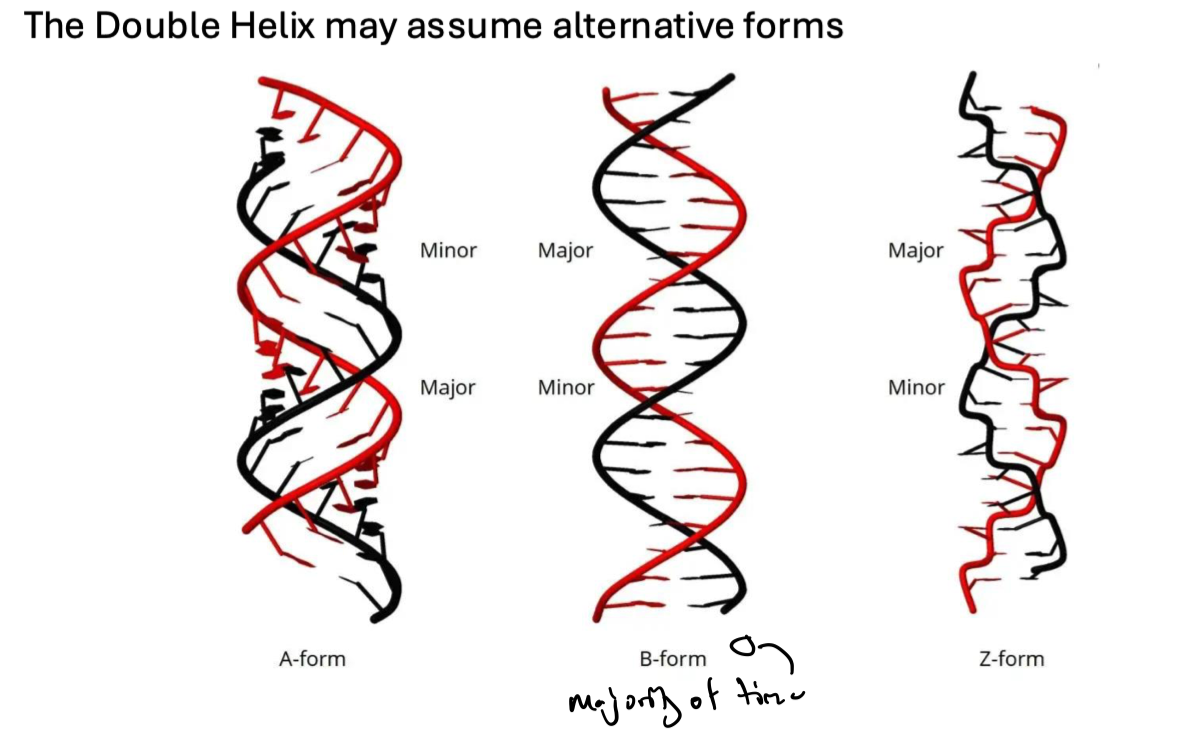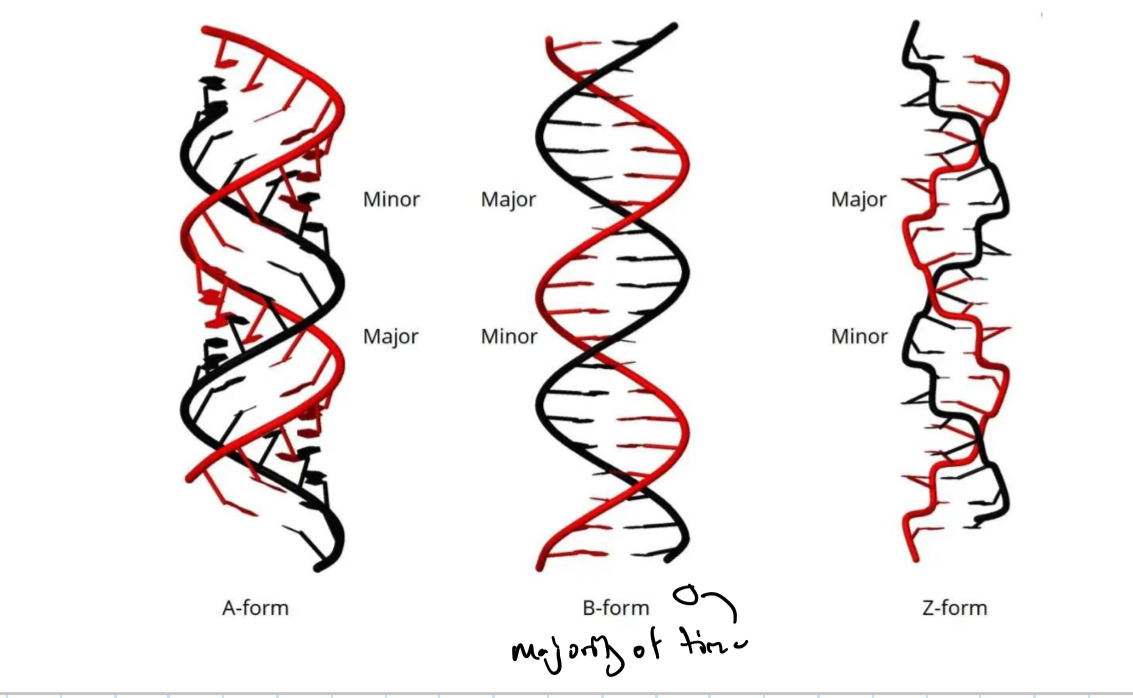Lecture 11: DNA and the Genetic Code
1/34
There's no tags or description
Looks like no tags are added yet.
Name | Mastery | Learn | Test | Matching | Spaced |
|---|
No study sessions yet.
35 Terms
what is nuclein
the old name for DNA → identified as weakly acidic, phosphorous-rich material from nuclei of human white blood cells
what was the major component of nuclein determined to be
DNA
what does the Schiff reagent do
stains DNA red → it was used to show it was almost exclusively located in the chromosomes
what do chromosomes consist of
DNA and proteins (DNA is compacted around proteins)

what does this experiment show
microbes need to be ALIVE to cause disease

what is transformation
the ability of a substance to change genetic characteristics of an organism
the genetic alteration of a cell resulting from the direct uptake and incorporation of exogenous material

which experiment showed transformation of streptococcous
heat killed S cells (disease causing variant of strep)
incorporated R cells w them (non disease causing variant of strep)
when gave “harmless” R cells to mice it killed them
when analyzed mice tissue it showed living S cells
explain the transforming principle
the thing that made R streptococcus cells S streptococcus cells
the transforming principle could be added to living R cells and S cells would be produced given sufficient time → they were getting their genetic info somehow → that genetic info is the transforming principe (the thing that sparked the transformation)
how did people initially determine what the transforming principle was (include what proteases, RNase, DNase, and ultracentrifugation do)
they isolated and purified the transforming principle then ran a series of tests with diff samples, each destroying a substance that might have been the transforming principle, then seeing if R cells were transformed into S cells once the samples were introduced to an R colony
protease → destroys proteins
RNase → destroys RNA
DNase → destroys DNA
ultracentrifugation → destroys fats
transformation only didn’t occur when samples of purified transforming principle were treated with DNase
therefore the transforming principle was DNA

what are viruses
not alive (do not have cells)
made up of only protein and DNA or RNA (protein + 1 type of nucleic acid)
what are bacteriophages
viruses that infect bacteria
often called “phages” for short
explain the lifecycle of a bacteriophage
phage attaches to bacterium (host)
injects its genes into host
phase DNA replicates, new phage proteins are made
phage particles assemble
cell bursts, releasing new phages
note: genetic material used to replicate phages is inside the bacterial host
another note: after injection, ghost particle of phage remains attached to the outer surface of the bacterial cell
after injection, where does the ghost particle of a bacteriophage go
it remains attached to the outer surface of the bacterial cell
how were bacteriophages used to further distinguish DNA from protein as the transforming principle (the genetic material of a cell)
injected one bacteriophage (T2 phage) into a phosphorous containing medium (so as they grew they would use that P to make their DNA
radiolabels DNA
injected another bacteriophage into a sulphur containing medium so they would use sulphur to make their proteins
radio labelled proteins
after infection, phage ghosts and bacterial cells were separated via centrifugation
bacterial cells end up in pellet
phage ghosts end up in supernatant
looked for which of these substances was found in the infected bacterial cell
→ radiolabeled P :. DNA was in the pellet (bacterial cells)
→ radiolabeled S :. proteins were in the supernatant
so DNA carried genetic info
what are the 3 components of DNA
deoxyribose sugar
phosphate group
nitrogenous base
what are the 4 types of nitrogenous bases
Adenine (A)
Guanine (G)
Thymine (T)
Cytosine (C)
what is each “building block” of DNA called
a nucleotide
how are nucleotides linked
in a directional chain
phosphodiester bonds form covalent link btwn 3’ carbon of one nucleotide and 5’ carbon of the next nucleotide
in what direction are nucleotide sequences written in by convention (unless stated otherwise)
5’ to 3’
what pieces get incorporated into DNA during DNA synthesis
deoxyribonucleoside triphosphates (dNTPs)
contain 3 phosphate groups (instead of 2 when on DNA)
P groups hold a lot of energy
the E gained by cleaving those bonds gives it energy to add them to the larger DNA molecule
which nitrogenous bases repeatedly occur at basically the same rates and what does that mean
A/T and C/G → means they bind tg
what is the diameter of DNA
20 angstroms
what does x-ray difraction of purified DNA show
that DNA was spiral-shaped (helical)
what is the basic structure of DNA
anti-parallel strands held tg by hydrogen bonding btwn base pairs
one complete turn every 34 angstroms
how big is an angstrom
1 angstrom is 1 ten-billionth of a meter
t/f: double helixes can have many alternative forms
true

which form of a double helix is the form DNA takes the majority of the time
the B-form

t/f: chromosome structure varies
true
where are linear, double-stranded chromosomes found
eukaryotic nuclear genomes
where are circular, double stranded chromosomes found
most bacteria, mitochondria, chloroplasts
where is single-stranded DNA usually found
many viruses
what things have no DNA in them
retroviruses (RNA viruses) → have RNA genomes
what kinds of bonds are involved in complimentary base pairing
hydrogen bonds
in double stranded DNA molecule, if 18% of bases are thymine (T) what percent are guanine (G)

if a DNA molecule of 422 base pairs contains 88 adenosine bases (A) how many guanine bases (G) will it have
334